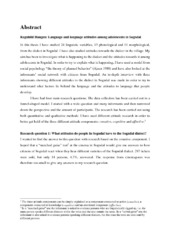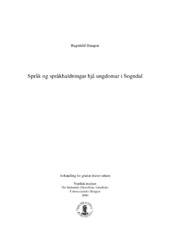| dc.description.abstract | In this thesis I have studied 24 linguistic variables, 13 phonological and 11 morphological, from the dialect in Sogndal. I have also studied attitudes towards the dialect in the village. My aim has been to investigate what is happening to the dialect and the attitudes towards it among adolescents in Sogndal. In order to try to explain what is happening, I have used a model from social psychology “the theory of planned behavior” (Ajzen 1988) and have also looked at the informants’ social network with citizens from Sogndal. An in-depth interview with three informants showing different attitudes to the dialect in Sogndal was made in order to try to understand what factors lie behind the language and the attitudes to language that people develop. I have had four main research questions. The data collection has been carried out in a funnel-shaped model. I started with a wide question and many informants and then narrowed down the perspective and the amount of participants. The research has been carried out using both quantitative and qualitative methods. I have used different attitude research in order to better get hold of the three different attitude components: conative, cognitive and affective.1 Research question 1: What attitudes do people in Sogndal have to the Sogndal dialect? I wanted to find the answer to this question with research based on the conative component. I hoped that a “matched guise” test2 at the cinema in Sogndal would give me answers to how citizens of Sogndal react when they hear different varieties of the Sogndal dialect. 297 tickets were sold, but only 14 persons, 4,7%, answered. The response from cinemagoers was therefore too small to give any answers to my research question. Research question 2: What attitudes do adolescents in Sogndal have to the dialect in Sogndal? I wanted to answer this question by doing a “verbal guise” test among all the pupils at Sogndal secondary school the year 2000/2001. I asked 153 pupils to listen to three varieties of the dialect in Sogndal: a traditional (variety 1), a newer (variety 2) and the most modern (variety 3). In this research I mainly wanted to focus on the affective component. I regard these pupils aged 14 – 16 as a random selection of adolescents in Sogndal, in the sense that they represent their adolescent age-group both some years back and some years into the future as long as there are not any major changes in the society of Sogndal that could influence the dialect and people’s attitudes towards it. The results of this research showed that the girls made more positive comments about all the three linguistic varieties of the dialect in Sogndal than the boys. This difference was significant for variety 2. Within the category of girls and boys, the girls were most positive to variety 2, whilst the boys were most positive to variety 1. Regarding parental background, informants whose parents both come from Sogndal were most positive to all the varieties. For variety 2, there was a significant difference between informants with both parents from Sogndal and those with neither parent from Sogndal, and between informants with one or both of their parents from Sogndal for variety 1 and 2. The pupils in year eight were significantly more positive to variety 3 than the pupils in years nine and ten. After the “verbal guise” test, the pupils were given more information about the next stages of the project and were encouraged to take part. 74 pupils wished to participate, and I picked out 36 of these informants based on the criteria of parental background and gender. These 36 informants were asked to evaluate their own dialect (main focus on the cognitive component) in relation to the three varieties of the dialect in Sogndal. Later, on the tape recordings, they gave statements (a mixture of the cognitive and the affective component) about the dialect in Sogndal. Results from the direct methods showed that about half of the boys evaluated their language as being most like variety 1, whilst most of the girls were spread over variety 2, 3 or “other”. The same pattern arose on the tape recordings, i.e. the boys expressed themselves more positively about the dialect in Sogndal than the girls. In the self-evaluation, there was a tendency that informants with parents from Sogndal evaluated their language as being most like one of the three varieties to a higher degree than informants with no parents from Sogndal. The same pattern was evident in the tape recordings, i.e. informants with one or two parents from Sogndal declared themselves more in favour of the Sogndal dialect than those without that parental background. Informants from year eight evaluated their language as being closest to variety 3, informants from year nine closest to variety 1 and informants from year ten closest to variety 2. Also, on the tape recordings, informants from year nine seemed to be the ones who were most positive to the traditional Sogndal dialect (variety 1). Research question 3: What characterises the dialect among adolescents in Sogndal? In my research with data from 1996 I had 18 linguistic variables and 30 informants aged between 17 and 83. At least one of the informants’ parents had to come from Sogndal. The linguistic variables were then divided into two varieties: A traditional (variety 1) and a newer (variety 2). The word ‹lay› (Norwegian: ‹leggja›) would for instance be pronounced / / according to variety 1 and / / according to variety 2. In the new research in 2001 I have determined 24 linguistic variables, where the six that were not there in 1996, now represent what I have called variety 3. Here there are for instance characteristics like / / / as in the word ‹church› (Norwegian: ‹kyrkje›) where the pronunciation will be / / according to variety 1 and / / according to variety 3. A comparison of the previous and present research shows that the new variants (variety 2) totally dominate in 2001. There is a significant difference between the size of the traditional category in 1996 (77,6% of all the informants and 71,6% of the 16 youngest (17 – 44 years)) compared with the size of the traditional category from the newer research (49% in the 2001 material). If the adolescents in Sogndal do not change their language towards more traditional Sogndal variants as they grow up, this is a sign of linguistic change in the Sogndal dialect. Most of the linguistic variants seem to be moving from variety 1 to variety 2. If we isolate the research from 2001 and add the six linguistic variables from variety 3, and the informants with no parents from Sogndal, the traditional per cent in 2001 is 58,7. The new variants connected to variety 3, for instance ao-dropping, have not caught on and have a relatively weak position in the Sogndal dialect. As in 1996, the research from 2001 shows boys to have a significantly higher traditional per cent than girls. Informants with two parents from Sogndal have a significantly higher traditional per cent than informants with only one parent from Sogndal, and the latter category also has a significantly higher traditional per cent than informants with no parents from Sogndal. There is a very high significant difference between girls and boys with both parents from Sogndal, but no significant difference between girls and boys with one or no parents from the village. Nor were there any significant differences between years eight, nine and ten. The accordance between the social and the linguistic variables must be explained. I have also obtained information about the same 36 informants’ social network. Amongst other things, here there were significant differences between the genders in that the boys had more contact with people from Sogndal speaking the Sogndal dialect than the girls. There were also significant differences between the amounts of Sogndal-contacts by informants with at least one of their parents from Sogndal compared with informants without parents from Sogndal. For the three school years there were only quite small differences here. Information from all the pupils about where they would like to live and work when they finish their education shows that there are significantly more boys than girls who say that they would like to live in Sogndal. Although this is a hypothetical question, the results all the same give indications about how girls and boys think. The information gives important signals about the future. Those who have thought of leaving the village when they grow up do not seem to be equally interested in taking care of and speaking the traditional Sogndal dialect. On the tape recordings many informants claim that it is important to visualise a certain connection to the dialect in Sogndal, but it seems as if they also can show this by speaking variety 2. Research question 4: Why do the adolescents in Sogndal speak the way they do? In order to understand why the informants speak they way they do, I picked out three of the 36 informants based on different traditional per cent and different attitudes to the Sogndal dialect. I also wanted to connect the results from the different research stages to these informants and put it all into Ajzen’s model “the theory of planned behavior”. This model which is composed by the three components Attitude toward the behaviour, Subjective norm and Perceived behavioural control, worked all right as a list of factors that can influence action. On the other hand, the model cannot predict how people speak, but it can illustrate the factors that visualise it. It does nevertheless not say anything about the relative strength of the different factors; neither can the model tell anything about the informants’ inner motivation. The coherence between factors and speech seems to be best in regard to the direct attitude research. The three depth-informants gave me the impression that the social norms they had acquired during their contact with parents and their friends in their closest social network were the strongest source of influence on their language. This contact also to a great extent showed what norms they had internalised, what they valued and whom they most identified with. | en_US |

